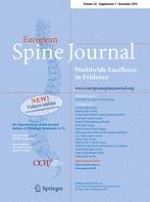Erschienen in:

01.11.2015 | Original Article
The surgical vascular anatomy of the minimally invasive lateral lumbar interbody approach: a cadaveric and radiographic analysis
verfasst von:
Mustafa Alkadhim, Carmine Zoccali, Salman Abbasifard, Mauricio J. Avila, Apar S. Patel, Kamran Sattarov, Christina M. Walter, Ali A. Baaj
Erschienen in:
European Spine Journal
|
Sonderheft 7/2015
Einloggen, um Zugang zu erhalten
Abstract
Purpose
The minimally invasive (MI) lateral lumbar interbody fusion (LLIF) approach has become increasingly popular for the treatment of degenerative lumbar spine disease. The neural anatomy of the lumbar plexus has been studied; however, the pertinent surgical vascular anatomy has not been examined in detail. The goal of this study is to examine the vascular structures that are relevant in relation to the MI-LLIF approach.
Methods
Anatomic dissection of the lumbar spines and associated vasculature was performed in three embalmed, adult cadavers. Right and left surgeon perspective views during LLIF were for a total of six approaches. During the dissection, all vascular elements were noted and photographed, and anatomical relationships to the vertebral bodies and disc spaces were analyzed. In addition, several axial and sagittal MRI images of the lumbar spine were analyzed to complement the cadaveric analysis.
Results
The aorta descends along the left anterior aspect of lumbar vertebra with an average distance of 2.1 cm (range 1.9–2.3 cm) to the center of each intervertebral disc. The vena cava descends along the right anterior aspect of lumbar vertebrates with average distance of 1.4 cm (range 1.3–1.6 cm) to the center of the intervertebral disc. Each vertebral body has two lumbar arteries (direct branches from the aorta); one exits to the left and one to the right side of the vertebral body. The lumbar arteries pass underneath the sympathetic trunk, run in the superior margin of the vertebral body and extend all the way across it, with average length of 3.8 cm (range 2.5–5 cm). The mean distance between the arteries and the inferior plate of the superior disc space is 4.2 mm (range 2–5 mm) and mean distance of 3.1 cm (range 2.8–3.8 cm) between two arteries in adjacent vertebrae. One of the cadavers had an expected normal anatomical variation where the left arteries at L3–L4 anastomosed dorsally of the vertebral bodies at the middle of the intervertebral disc.
Conclusions
Understanding the vascular anatomy of the lateral and anterior lumbar spine is paramount for successfully and safely executing the LLIF procedure. It is imperative to identify anatomical variations in lumbar arteries and veins with careful assessment of the preoperative imaging.